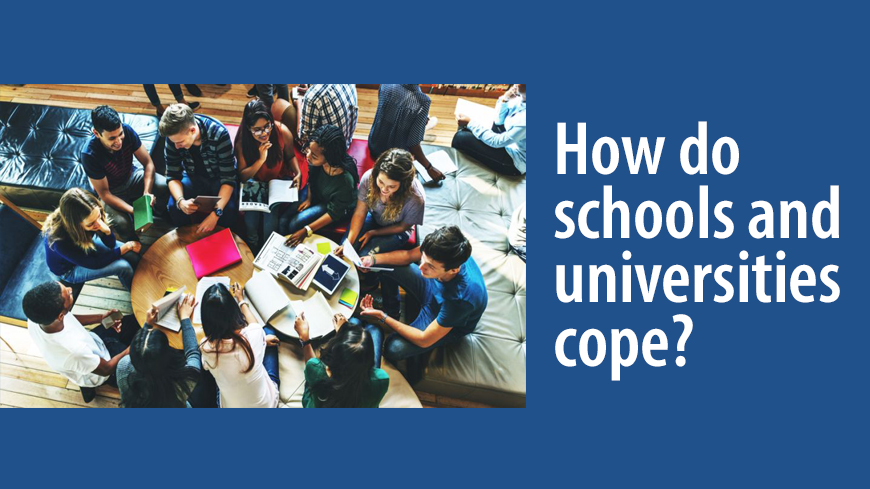Responses from schools in Serbia
Among the numerous challenges faced by your school in the current COVID-19 crisis, which was the most difficult?
The difficulties we encountered in organising online classes were all related to the benefits of traditional teaching: the lack of two-way communication, many forms of classes were no longer possible (practical classes or laboratory exercises), it was much more difficult to monitor student progress and make objective assessments and give grades in relation to their progress and demonstrated knowledge. Another big challenge was with students who needed the extra support they used to get from teachers and peers. They now find it difficult to cope with in an online environment. Some students come from economically deprived families and lack the technical equipment to follow online classes. Also, we have students whose parents have a low level of education and are not able to support them in learning. An additional problem is that the school no longer has an insight into other difficulties our students may face: do students need counselling support, do they suffer domestic violence, or they need social assistance, etc.
Ways to overcome these difficulties and challenges: we are not insisting on 100% achievement of the educational goals; when grading students we take into account incentives and motivation for students to continue learning (evaluated applying KNWISO scale); we encourage peer support - students who easily learn the materials can be “mentoring” students who are struggling.
Which innovative solution(s) you have found in handling this crisis, that you would like to share with other schools
Initially, there was a great deal of scepticism about the implementation of online classes, but the benefits were quickly noticed:
- using Google Disk to easily and quickly share information necessary to conduct classes;
- various applications and web tools have been quickly and easily mastered to facilitate online classes;
- teachers began creating learning content and tasks to upload on the Google Classroom platform.
We conducted an online survey on the quality of online classes and received very satisfactory results from students. The students indicated that there was a need to set up a Google Classroom by subject, the time when lessons are set, assignment deadlines and time for feedback. A new organisation and schedule for online teaching was agreed for Zoom conferences with teachers, and henceforth the days of the week, the lessons’ subjects, materials and assignments are specified on the platform, as well as deadlines for feedback. It was agreed to post lessons and materials once a week at an allotted time, with students being able to request a consultation on the Viber Group or by email at the time provided in the class schedule.
Marsela Eschenasi Milutinović, Teacher
Aleksandra Jovankin Aleksić, Teacher
Among the numerous challenges faced by your school in the current COVID-19 crisis, which was the most difficult?
We faced a lot of challenges during the current COVID-19 crisis, and it is very hard to identify one in particular as the most difficult. Initially, the biggest challenge was communication and planning the lessons for all students, especially for students who lacked the technical equipment to follow classes online. Parallel to this challenge was the difficulty of teachers who lacked the competences for carrying out digital lessons. Choosing a suitable platform for communication with the students was also challenging.
After we had managed the initial challenges, another emerged - how to keep track of students' work, especially the students whose materials are sent by e-mail. Students that have individual education plans and need additional support presented further challenges, as they were not getting adequate support since the schools’ closure. The most recent challenge is the lack of interest in classes, not only from students but also from parents.
With all these challenges in mind, possibly the biggest is how to motivate students to commit to learning in these circumstances of fear, uncertainty and stress, as well as how to preserve their mental health and that of teachers.
Which innovative solution(s) you have found in handling this crisis, that you would like to share with other schools?
After the second week of online classes, we conducted a survey amongst students, parents and teachers to learn more about their first impressions and workload. The results were used to make adaptions to the classes and to enrich their content, in line with students’ needs. Accordingly, we started using Google Classrooms as a platform for teachers to deliver their lessons, in addition to video calls for teacher-student communication.
We next adjusted school plans, programmes and project action plans. We drew up a list of activities we could carry out with students online so that the situation before and after the state of emergency resembled each other as much as possible and activities were adapted accordingly. Thanks to this, we were able to continue exchanges between teachers, but merely through a different communication channel. In addition, we put a lot of emphasis on professional development since a lot of trainings had become accessible and were now free of charge (we received a lot of support materials from Hungary).
We continued developing peer learning not only among students but teachers as well. We are currently planning to pair students and teachers who have better digital knowledge with the ones who need some help. In addition to all this, we managed to provide students with technical assistance where possible (pre-paid internet or internet routers). For students who lacked the technical equipment to follow online classes, we teamed up with the municipality and organised a group of volunteers to take materials to the students once a week and bring back their finished assignments to the teachers.



